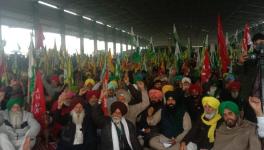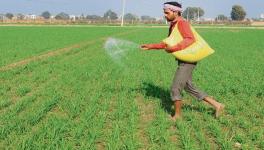Farmers’ Suicides in West Bengal: A Preliminary Analysis
Over the last 15 years more than 2 lakh farmers have committed suicide in the country due to debt related problem and an acute agrarian crisis.
This phenomenon was outside the lived experience of the people of West Bengal and came only as news from distant places. But with the Trinamool Congress led government coming to power in West Bengal, a significant change has happened in West Bengal countryside, where the phenomenon of farmer suicides have now become a part of rural life in the state. In the last 8 months 34 farmers have committed suicide in the state due to debt related problems and non-remunerative prices of the crop. The question is what explains this sudden acute problem of farmers in the state. In order to comprehend the problem, it is important to understand the overall national context of the agrarian situation in the country. Therefore, we start with a discussion on this aspect before going into the particularities of West Bengal.
Neo-liberalism and Agrarian Crisis in India
Agriculture in India has been the worst sufferer in the aftermath of pursuing neo-liberal policies. With the new policy regime imposed on the people in 1991, the government reduced its role in the agriculture sector. This was done in myriad ways. Firstly, the total gross capital formation in agriculture as a proportion of total gross capital formation in the country has declined. This ratio was 15.4% in 1980-81, subsequently declined to 9.9% in 1990-91 and declined to 7.7% in 2009-10. This essentially shows that there has been a sharp decline in investment in agriculture. This sharp decline in agricultural investment on the other hand is led by a decline in public sector investment in agriculture. If we look at public gross capital formation in agriculture as a proportion of total gross capital formation in the economy, then it has declined from 17.7% in 1980-81 to 7.1% in 1990-91 and further declined to 5.9% in 2008-09. This decline in public investment in agriculture is also manifested from the fact that out of the total plan outlay only 4.9% was allocated for agriculture and allied sector in the IX Plan, which declined to 3.9% in the X plan and further reduced to 3.7% in the XI plan.[1] Such an all-round decline in public investment in agriculture was not matched by commensurate increase in private investment resulting in an overall decline in agricultural investment in the country.
With such decline in agricultural investment, the growth rate of production in agriculture is bound to take a hit. The following table shows the growth rate of agriculture in the various plan periods in the country.
Table 1: Growth rate of agriculture in various plan periods
|
Plan Period
|
Growth Rate
|
|
8th Plan (1992-97)
|
4.69
|
|
9th Plan (1997-2002)
|
2.06
|
|
10th Plan (2002-07)
|
2.2
|
|
11th Plan (2007-12)
|
3.0
|
Source: Planning Commission
Note: The growth rate for the 11th Plan is the expected growth rate
This slowdown in growth rate of agriculture has resulted in a situation where the share of this sector in the GDP was only 14.6% in 2009-10.[2] However, this sector employs 67.6% of the labour force in rural areas and 7.5% in urban areas in 2009-10.[3] This essentially means that even with a high growth rate of GDP and slowdown in agriculture, the growth process has failed to absorb labour in the non-agricultural sector. Therefore the agriculture sector continues to be a repository of low income and poverty.
While there has been a substantial slowdown in agricultural production in the country, the central government has liberalized agricultural trade by cutting down tariffs on agricultural commodities and allowing imports of agricultural products. This has resulted in a situation in which the farmers of India have been exposed to the price volatility of the global commodity market. This is more so in the case of cash crops. In fact, a major proportion of farmers who have committed suicide in Kerala or Maharashtra are cash crop farmers cultivating vanilla, coffee etc in the case of Kerala and mostly cotton in the case of Maharashtra. With a drastic fall in the global prices of these commodities in the beginning of 2000s, the return on farming for these sections of the farmers collapsed driving many of them into suicide. If these farmers were not exposed to the global price movements then a significant number of farmers would not have been pushed towards suicide.
On the other hand, there has been a substantial reduction in subsidies provided to the agriculture sector, in particular the subsidies for fertilizers have been reduced drastically. In 2009-10, Rs 61264.29 crore was provided as fertilizer subsidy. However, in 2011-12, only Rs 49997.67 crore is being provided.[4] Moreover, prices of certain fertilizers have been decontrolled, which creates another upward pressure on the prices of this essential agricultural input. Additionally, the government has reduced agricultural extension services, which again adversely affects the farmers.
All this has resulted in an increase in cost of cultivation. The real cost of production for rice and wheat are shown in the following table
Table 2: Growth Rate of Real Cost of Production for Rice and Wheat
|
Year
|
Rice
|
Wheat
|
|
1981-82 to 1992-93
|
-0.13
|
-1.96
|
|
1994-95 to 2006-07
|
1.92
|
1.96
|
Source: Agricultural Price Policy, Farm Profitability and Food Security: An Analysis of Rice and Wheat, S Mahendra Dev, _ Chandrasekhara Rao, Commission for Agricultural Costs and Prices (CACP)
Note: Cost is calculated as Cost of Production per Quintal of rice/wheat
From the above it is clear that with the advent of the policies of liberalization, the cost of production for the two major crops in India has increased. This increase in cost of production is primarily because of an increase in input prices. According to the reply of the government to a question posed in Lok Sabha on 23-08-2011,
“The prices of major agricultural inputs and implements during 2005-06 to 2011-12 (till July, 2011) have increased by 22.2% for fertilizers, 10.7% for pesticides, 32.0% for diesel, 29.8% for tractors and 32.3% for pumps & assembly in terms of Wholesale Price Index (WPI). As per the available data, the prices of seeds of various crops have increased from about 13.5% to 55.5% during 2005-06 to 2010-11.”[5]
This massive increase in the prices of inputs is a direct result of the policies pursued by the central government entailing a cut back on crucial subsidies and deregulating prices of inputs like fertilizers. On the face of such an increase in cost of cultivation, the only way to keep farming viable is to increase the Minimum Support Price (MSP). But the MSP is given for a selected number of commodities and not all commodities. Therefore, such an all-round increase in the input costs of cultivation is bound to adversely affect the lives and livelihoods of millions of farmers in the country.
It is in this backdrop that the agriculture sector in West Bengal is operating. However, it must be noted that while all the above mentioned factors were operating in India, West Bengal did not witness any farmer suicide during the period when thousands of farmers have committed suicide in the country. The crucial issue that needs to be analysed is what has changed in the last 7-8 months that farmers are suddenly committing suicide in large numbers in the state. We now turn to discuss the case of West Bengal in greater details.
Agrarian Situation in West Bengal
Since October 2011, 34 farmers have committed suicide in the state of West Bengal. Most of these 34 farmers are poor or marginal peasants and some of them are poor agricultural labourers. Most of these farmers are paddy and potato farmers who took loans to cultivate their land. But they did not get any remunerative price for the product which left them indebted without any prospect of repaying these loans. Driven to desperation and social embarrassment, they took their own lives.
Although the pattern of the farmer suicides in West Bengal, in terms of indebtedness and non-remunerative prices generally follow the pattern of such suicides in other states, there is a crucial difference. This difference lies in the fact that most of these farmers are food crop farmers like rice and potato. Being food crop farmers, they are largely insulated from the volatility of global commodity prices, which spelt doom for thousands of cotton or coffee growing farmers in the country. Secondly, for paddy growers, the central government has instituted the MSP, which theoretically at least is supposed to not only cover the cost of production but also give some profit margin to the farmers. However, the fact that the paddy growing farmers are committing suicide in the state points towards an acute governmental and policy failure. As far as the potato farmers are concerned, a bumper crop of potato has the potential of crashing the market price. But government intervention in the past did not allow such a situation to arise. The fact that potato growing farmers are committing suicide points again towards governmental and policy failure to deal with the eventuality of any such crash in prices.
The Issue of MSP
As has been the case in rest of the country, the cost of cultivation of paddy has increased in West Bengal too. In the year 2007-08, the total cost of cultivation of paddy per hectare of land was Rs 28141 which increased to Rs 33046 in 2008-09. The CACP projects that for the year 2011-12, the cost of cultivation of paddy per hectare has increased to Rs 38868.[6] Therefore according to the data of the competent authority itself, the cost of cultivation of paddy will witness a substantial increase in West Bengal. If we convert this cost in per quintal terms, then for the year 2011-12, the figure comes to Rs 896 per quintal of paddy.[7] Given these facts, there are some glaring problems with the way in which the problem of procurement of rice and paying MSP has been done in the state.
Let us first look at the issue of MSP. Last year the MSP announced by the Central Government for a quintal of rice was Rs 1050. The erstwhile Left Front government announced a bonus of Rs 50 per quintal so that the farmers received Rs 1100 per quintal of rice. This year the Central Government has announced an MSP of Rs 1080 per quintal. But the current TMC-led government has not announced any bonus for the farmers. As a result, the farmers are getting a price which is lower than last year’s. Therefore, prima facie, the farmers are worse off than last year in terms of prices, while their cost of cultivation has increased. This is a perfect recipe for a debt problem in the agrarian sector of any economy.
The problem however does not end with a lower effective MSP for the farmers. The farmers will get the MSP only when the government procures from them. In this regard, the record of the current government has been abysmal. The state government till 20th January 2011, has procured 2.11 lakh metric tonnes of rice and 57355 tonnes of paddy. Last year, the total procurement by the state government was 4.55 lakh tonnes of rice and 11.76 lakh tonnes of paddy, whereby the total procurement from the state was at 13.10 lakh tonnes of rice.[8] It is obvious that compared to last year, the procurement drive of the current government has been a total failure. From certain quarters of the government, it is being propagated that the procurement has fallen because the Food Corporation of India (FCI) has procured less. This is nothing but a white lie. In the current year the FCI has procured 71996 metric tonnes of rice, while last year it had procured only 67039 metric tonnes of rice.[9] Therefore, the FCI has actually procured more rice this year; it is because of the complete failure on the part of the government that the procurement has been abysmal this year.
It is absolutely not the case that the decline in the procurement of the government is because of a fall in the production of paddy/rice. Rather, the problem is that this year there is a bumper harvest of paddy. On the face of such huge production, the necessity of the government to buy from the farmers becomes even more since in the absence of governmental intervention, the price of paddy may collapse in the open market leading to acute distress of the farmers. But, this is where the government has completely failed by not procuring enough from the farmers. What has happened is that the government has asked certain rice mills to procure from the farmers. But these rice mills are dilly-dallying on making payments to them. In certain cases they have made payments in cheque, which has bounced. With surplus grain lying in the godown, the farmers have been forced to go for distress sale, leading to a fall in their prices and hence foreclosing the possibility of earning any return on the farmers’ investment in the crop. Some farmers with the possibility of a price crash are unable to sell their crops. While for others, with the distress sale phenomenon, they are being paid less than the MSP by the rice mills. In this situation, it is but obvious that the farmers are unable to meet their debt obligations and other expenses leading to a desperate step like suicide.
This policy of relying on the rice mills only to procure from the farmers is in sharp contrast with the procurement policy of the Left Front government, where the government used to involve all government and semi-government agencies, rural cooperatives and the Self Help Groups to procure paddy from the farmers. This had a twin advantage. Firstly, with such decentralized procurement policy, the farmers did not have to transport their grains to long distances to sell them to the rice mills. Secondly, the social intimacy of the Self Help Groups, panchayats with the farmers in the villages enabled the government to understand the situation better. This entire approach of decentralized procurement has been done away with. Moreover, the TMC led government has made the panchayats defunct and are trying to rely on the bureaucracy for policy implementation in the villages. This has ensured that elected representatives of the people are bypassed and the bureaucracy takes over in crucial matters related to the villages, who are distant from the actual problems on the ground.
The plight of the potato and jute farmers follows a similar story. The MSP for jute was set at Rs 1675 per quintal. While the Chief Minister wrote to the central government to increase this by Rs 400, she took no initiative to ensure that the Jute Corporation of India sets up procurement centres in the state to buy jute from the farmers. The central government did not respond to her demand and JCI did not open up procurement centres, as a result the farmers were forced to sell their crops under distress and in the process ended up making huge debts from local money lenders and banks. The plight of the potato farmers followed a similar story. With bumper harvest of potato and the state government doing nothing to resist price crash, the price of potato has decreased to 20 paisa per Kg because of which the farmers are getting zero return on their investment.
Dismal Performance in NREGA
On the face of such problem of farmers and agricultural labourer in the state, the National Rural Employment Guarantee Scheme would have provided some relief to the rural population. However, in this regard too, the government has been an utter failure. In the current financial year (2011-12) upto the month of December, 438.41 lakh mandays of employment have been generated, while Rs 125173.49 lakh being the total expenditure. During the same period last year (2010-11), 910.71 lakh mandays of employment was generated with a total expenditure of Rs 153816.63 lakh. On an average only 14.4 days of employment has been provided in West Bengal till date this year, while the provision is for 100 days. This is the second lowest in the country. Only Arunachal Pradesh has generated less number of average days of employment under NREGA.[10] In other words, compared to the performance of NREGA under the Left Front government, the TMC-led government has performed dismally. This has prompted the Minister of Rural Development of Government of India to write a letter to the West Bengal government pointing out that the performance of the state has been dismal under NREGA.
Political Economy of the Government’s Role in the Agrarian Problem
At this point a legitimate question can be asked as to why the government did not take any initiative to provide relief to the farmers and has gone on a denial mode saying that there has been no farmer suicide in West Bengal. In order to understand the problem one needs to look at the social class basis of the Trinamool Congress. In 2001, when the Left Front came to power the Trinamool had won 45.7% of the votes of the rich classes in West Bengal.[11] The very high vote share of the rich for the TMC at a time when the Left Front was winning elections after elections shows that the rich always supported the TMC and this is their core mass base. It is undoubtedly the case that the TMC managed to win a large chunk of the vote of the poor and lower income category (48%) in 2011 elections when it won the elections. But it has also increased its vote share to 49% amongst the rich.[12] As the interests of the rich and the poor in most of the cases are contradictory, it is impossible to keep the vote share of both the classes intact. But, the fact that the rich consolidated their support in favour of the TMC at a time when the electoral fortunes of TMC were grim shows that for the TMC, the rich class is a dependent ally. It is for this reason, that while the TMC supremo indulges in a lot of left rhetoric, when it comes to reality, the government is failing to take care of the problem of the looming agrarian crisis.
This alliance between the rich and TMC is showing its most ugly face in the rural areas. Ever since the election results have been announced on 13th May, there have been systematic attacks on the bargadars (share-croppers) and marginal farmers in the state. The land of the tillers earned through decades of struggle has been re-captured in many places by the erstwhile landowners. According to a conservative estimate of the Kishan Sabha, over the last two and half months, land of 527 farmers amounting to 1000 acres of riot land has been snatched away. Additionally, 4700 patta-owners have been evicted from 2700 acres of land, 3710 bargadars have been evicted from 1587 acres of land while 14025 persons have been evicted from legally acquired land. In fact the police resorted to firing when farmers were resisting forceful eviction from their land at Haroa in North 24 Parganas district. The fact that the landlord and rich peasant classes in rural West Bengal could mount an attack on the peasantry to reverse the gains of land reform after the TMC came to power shows that this class feels that their time to try and recapture lost ground has come with the coming to power of the TMC government. In essence then the rural rich feel that the government will provide protection to them.
The attempt of the government to paralyze the panchayati raj institutions of the state, which were the prime democratic institutions in rural West Bengal is yet another example of how the government is trying to protect the interests of the rich and the powerful. Through the panchayats, democracy and empowerment was ensured for the rural masses. But now this institution is under attack. The TMC-led government has decided that they will bypass these democratic institutions and undertake rural development by bureaucratic means through the office of the BDO. This is however only the tip of the iceberg. The real reason lies in the fact that the Trinamool Congress wants to do away with the functioning of the panchayats in the state. The Chief Minister had said on record that she wants ‘non-political’ elections to the panchayats, which is essentially a euphemism for robbing the panchayats of its democratic vitality.
The non-functioning and the denial of the government of the phenomenon of farmer suicides stems from the fact the core support base of the TMC has not been affected. It can be however argued that the TMC came to power after mobilizing people on peasant issues. So it is wrong to say that its core base is not affected. While it is true that the issues of Singur and Nandigram did play a part in the defeat of the Left Front, it is also the case that the TMC-led government till date has not announced a single policy which will benefit the farmers. The return of land in Singur will benefit a small number of farmers who will perhaps get back the land after long legal battles. But the farmers of West Bengal have gained nothing from the government in terms of any policy announcement in favour of them. Rather, the response of the government has been a denial of any problem in the agrarian sector. On the other hand, the CM has been busy with summit with the industrialists, beautification project of the riverside in Kolkata, beach festival at Digha etc. But she has not visited a single village where farmers are committing suicide. This clearly shows that the CM is happy to realize the aspirations of the middle and rich classes but not the poor.
The total apathy shown by the government towards the plight of the farmers is only intensifying the crisis. In this situation, the only way forward is to organize the farmers and fight for their rights. Such mobilizations are happening on the ground. On 4th January, West Bengal witnessed a historic strike of the farmers against the anti-farmer policies of the central and state governments. The entire countryside came to a standstill with the farmers instead of tilling their fields organized pickets, processions and protest actions. More such actions are the call of the day. Instead of committing suicide, the farmers need to mobilize as a collective against the government. In this struggle, the solidarity of all of us is extremely important. The farmers should not feel alone and despondent. The democratic people of the state stand in solidarity with them in this struggle.
[1]All data in this paragraph is quoted from Agricultural Statistics at a Glance and Economic Survey, various issues
[2] Agricultural Statistics at a Glance
[3]“ Employment in India: What Does the Latest Data Show?”, Subhanil Chowdhury, Economic and Political Weekly, August 6, 2011
[4] Budget Document
[5]Answer to question no. 286, Lok Sabha, 23-08-2011
[6] CACP Report on Price Policy for Kharif Crops, 2011-12
[7] Same as above
[8] Food Corporation of India website
[9]Same as above
[10] All data are from www.nrega.nic.in
[11] Making and Unmaking of Trinamul Congress, Dwaipayan Bhattacharyya, Economic and Political Weekly, April 3-10, 2004
[12] Fifteenth Assembly Elections in West Bengal, Economic and Political Weekly, June 18, 2011
Get the latest reports & analysis with people's perspective on Protests, movements & deep analytical videos, discussions of the current affairs in your Telegram app. Subscribe to NewsClick's Telegram channel & get Real-Time updates on stories, as they get published on our website.
























